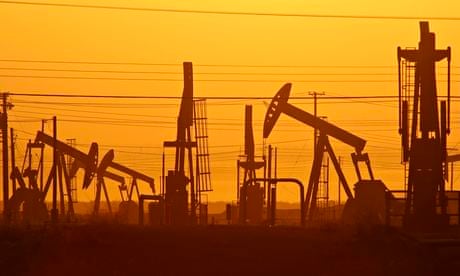Next month, the US Energy Information Administration (EIA) will publish a new estimate of US shale deposits set to deal a death-blow to industry hype about a new golden era of US energy independence by fracking unconventional oil and gas.
EIA officials told the Los Angeles Times that previous estimates of recoverable oil in the Monterey shale reserves in California of about 15.4 billion barrels were vastly overstated. The revised estimate, they said, will slash this amount by 96% to a puny 600 million barrels of oil.
The Monterey formation, previously believed to contain more than double the amount of oil estimated at the Bakken shale in North Dakota, and five times larger than the Eagle Ford shale in South Texas, was slated to add up to 2.8 million jobs by 2020 and boost government tax revenues by $24.6 billion a year.
Industry lobbyists have for long highlighted the Monterey shale reserves as the big game-changer for US oil and gas production. Nick Grealy, who runs the consultancy No Hot Air which is funded by "gas and associated companies", and includes the UK's most high-profile shale gas fracker Cuadrilla among its clients, predicted last year that:
"... the star of the North American show is barely on most people's radar screens. California shale will... reinvigorate the Golden State's economy over the next two to three years."
This sort of hype triggered "a speculation boom among oil companies" according to the LA Times. The EIA's original survey for the US Department of Energy published in 2011 had been contracted out to Intek Inc. That report found that the Monterey shale constituted "64 percent of the total shale oil resources" in the US.
The EIA's revised estimate was based partly on analysis of actual output from wells where new fracking techniques had been applied. According to EIA petroleum analyst John Staub:
"From the information we've been able to gather, we've not seen evidence that oil extraction in this area is very productive using techniques like fracking... Our oil production estimates combined with a dearth of knowledge about geological differences among the oil fields led to erroneous predictions and estimates."
The Intek Inc study for the EIA had relied largely on oil industry claims, rather than proper data. Hitesh Mohan, who authored the Intek study for the EIA, reportedly conceded that "his figures were derived from technical reports and presentations from oil companies, including Occidental Petroleum, which owns the lion's share of oil leases in the Monterey Shale, at 1.6 million acres." Mohan had even lifted his original estimate for the EIA to 17 billion barrels.
Geoscientist David Hughes, who worked for the Geological Survey of Canada for 32 years, said:
"The oil had always been a statistical fantasy. Left out of all the hoopla was the fact that the EIA's estimate was little more than a back-of-the-envelope calculation."
Last year, the Post Carbon Institute (PCI) published Hughes' study, Drilling California: A Reality Check on the Monterey Shale, which conducted an empirical analysis of oil production data using a widely used industry database also relied on by the EIA. The report concluded that the original EIA estimate was "highly overstated," and unlikely to lead to a "statewide economic boom.... California should consider its economic and energy future in the absence of an oil production boom."
A spokesman for the Institute, Tod Brilliant, told me:
"Given the incredible difference between initial projections of 15 billion barrels and revisions to 600 million, does this not call into account all such global projections for tight oil?"
As I'd reported earlier in June last year, a wider PCI study by Hughes had come to similar conclusions about bullish estimates of US shale oil and gas potential, concluding that "light tight oil production in the USA will peak between 2015 and 2017, followed by a steep decline", while shale gas production would likely peak next year. In that post, I'd pointed out previous well-documented, and alarmingly common, cases of industry over-estimates of reserve sizes which later had been questioned.
Analysts like Jeremy Leggett have said, citing exaggerated oil industry estimates, that if reserve and production reality are indeed significantly lower than industry forecasts, we could be at risk of an oil shock as early as within the next five years.
The latest revelations follow a spate of bad news for industry reassurances about the fracking boom. New research published this month has found that measured methane leaks from fracking operations were three times larger than forecasted. The US Environment Protection Agency therefore "significantly underestimates" methane emissions from fracking, by as much as a 100 to a 1,000 times according to a new Proceedings of the National Academy of Sciences study published in April.
The Associated Press also reported, citing a Government Accountability Office investigation, that the US Interior Department's Bureau of Land Management had failed to adequately inspect thousands of oil and gas wells that are potentially high risk for water and environmental damage.
Despite the mounting evidence that the shale gas boom is heading for a bust, both economically and environmentally, both governments and industry are together pouring their eggs into a rather flimsy basket.
According to a secret trade memo obtained by the Huffington Post, the Obama administration and the European Union are pushing ahead with efforts to "expand US fracking, offshore oil drilling and natural gas exploration", as well as exports to the EU, under the prospective Transatlantic Trade and Investment Partnership (TTIP) agreement.
Dr. Nafeez Ahmed is an international security journalist and academic. He is the author of A User's Guide to the Crisis of Civilization: And How to Save It, and the forthcoming science fiction thriller, Zero Point. Follow him on Facebook and Twitter @nafeezahmed.








Comments (…)
Sign in or create your Guardian account to join the discussion